| CPC G06T 3/4092 (2013.01) [G06T 15/00 (2013.01); G06T 2210/36 (2013.01)] | 19 Claims |

|
1. A method comprising:
receiving a plurality of image data that is defined at different positions in a three-dimensional (“3D”) space and that represents a 3D environment;
defining a view frustum as a particular volume in the 3D space that spans between a first depth and a second depth of the 3D space;
modeling a first amount of resolvable detail at the first depth of the view frustum, wherein modeling the first amount of resolvable detail comprises adjusting a first value derived from the first depth by a second value derived from one or more of a size of a display, a resolution of the display, or a viewer distance from the display;
modeling a second amount of resolvable detail at the second depth of the view frustum, wherein modeling the second amount of resolvable detail comprises adjusting a third value derived from the second depth by the second value;
rendering a first set of the plurality of image data with positions in the 3D space that are at the first depth and in the particular volume at a first resolution that presents the first depth of the view frustum with the first amount of resolvable detail; and
rendering a second set of the plurality of image data with positions in the 3D space that are at the second depth and in the particular volume at a second resolution that presents the second depth of the view frustum with the second amount of resolvable detail, wherein the first resolution is different than the second resolution.
|